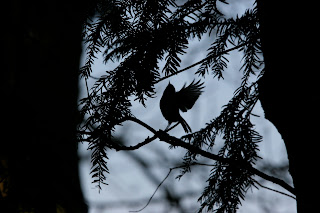The Golden Plover flock is anything but settled and it seems likely that
they have been harassed by a Peregrine or other raptor during recent days.
Several hundred of these beautiful waders shuffle nervously on the exposed mud
of one of the lagoons at Norfolk Wildlife Trust’s Cley reserve. A multitude of
gleaming black eyes alert to danger, it only needs one bird to take to the wing
and the rest of the flock erupts with a clearly discernable rush of wings. The
flock rises sharply, forming a coherent mass and taking on a life of its own,
pulsing and twisting in the air, flicking from gold upperwings to a flash of
white underparts. It is easy to see how a would-be predator might find it
difficult to single out a victim. Moments later, the flock having circled, and
birds begin to drop back down to the deck. Each time the flock goes up there
are groans from the other end of the hide. A juvenile American Golden Plover
was keeping company with this flock yesterday and some birdwatchers are keen to
pick it out from its mass of slightly larger, warmer coloured European
relatives.
When you see the spectacle of a decent flock of waders on the wing,
jinking and twisting through the air, it is easy to see their appeal. While
some waders can be considered beautiful in their own right, the sight of many
hundreds or thousands of individuals collected into a flock is truly amazing.
They are not the only flock present today, with several hundred sleeping Teal,
many dozen Wigeon and a sizeable number of Black-headed Gulls, but they are the
only spectacle. Every now and then the panic of the plovers triggers the gulls
to take flight. But with the gulls there is no synchrony, no sense of
individuals working together in unison. Instead, the gulls merely give a ragged
show – a random flurry of white, lacking direction and purpose.
Flocking provides a number of benefits, including those related to
predation risk. If you are part of a flock then your chances of being the
target of a predator are reduced. Having others of your kind with you when
feeding means that while you have your head down searching for food, another
individual will almost certainly have its head up scanning for predators.
Golden Plover often flock with other birds, especially when they are feeding,
and they can often be seen in the company of Lapwing or Black-headed Gulls.
While the smaller plovers may lose the odd piece of food to a larger gull,
again there are the benefits of having more eyes to watch out for predators.
And the benefit for us? A spectacular show.
